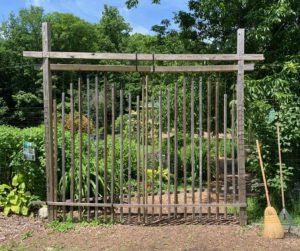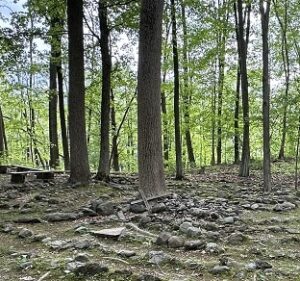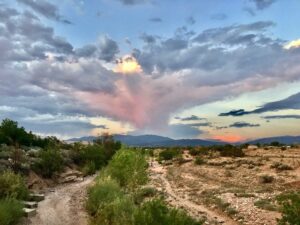Hello, fellow lovers of all things green. Labyrinths provide paths of healing to help you maneuver through loss and grief, but the contemplation benefits are all-encompassing and beautiful, too.
Comfort Zone Camp, in partnership with A Little Hope Foundation

Lynne Hughes, founder of Comfort Zone Camp in its 26th year of providing support free to families to help our youth grieve, heal, and grow.
I participated in Comfort Zone Camp, a grief camp for kids and young adults, the weekend before last. It’s the tenth year of a special camp in partnership with A Little Hope Foundation to support those who lost a loved one to suicide.
Over the years as a volunteer, the experience always brings a pause as I marvel over the bravery and resilience of our youth as they share their stories and connect with others, helping them not to feel alone in their grief. Many campers from years past have become volunteers serving as big buddies to the “littles” now attending camp. It’s heartwarming to see their growth.

Garden gates with narrow wooden posts tied to strings allow visitors to jockey a few aside to slip into the sanctuary.
Among the beauty of the Johnsonburg (NJ) Camp & Retreat Center, which hosted the camp, is a lovely butterfly garden— A Butterfly Garden of Growth. There’s also a labyrinth that I hadn’t been able to find despite the charming hand-drawn map they provide. Last year, I was driven to see it but reached a dead end and thought the labyrinth might be buried in the brush. This time, I made a mission to find it.
A labyrinth hidden among the trees
After all the participants left, I once again followed the map through the thick canopy of trees, not a human to be seen or heard—a stark shift from the boisterous sounds of close to 150 campers and volunteers. I smiled at the adventure reminiscent of my childhood days when I ditched my bike to explore the forest, each time going a bit further.

Leaning the cross upright felt sacred.
A wooden sign for the labyrinth pointed to the way, crooked and worn, adding to the eeriness of the heavily shaded route, though I adore walking amongst the trees. Then came a crossroads not on the map. I felt drawn to veer to the left. Shrubs tickled my ankles as I made my way about fifty more feet. To my delight, the charming labyrinth of rocks on the forest floor appeared, with moss and ferns naturalizing the edges.
A rustic cross had fallen next to the tree centered amongst the circles of stones. Slowly, I walked the pathways, taking in the serenity of the world around me. When I reached the end, I leaned the cross upright against the tree. It felt sacred.
History and How to Build a Labyrinth
Labyrinths are continuous meandering paths leading to the center of the design and back. They date back 4,000 years, representing a spiritual journey and reflecting the interconnectedness of all things. They are not to be confused with mazes that lead to nowhere, causing stress and confusion, although they’re fun to do as puzzles on paper to challenge the mind.
You can make a labyrinth with stones edging a woodland path or mow them into a lawn, allowing the areas around them to grow longer. Or, better yet, create the path amongst a meadow (Link to how to make a meadow below). Bricks or pavers set low in a lawn as a labyrinth allow you to maintain the grass readily. Or use gravel or a lawn alternative such as white clover for the walking paths. A labyrinth on Frenchy’s Field along the Sante Fe River in New Mexico is made of clay-rich soil mixed with straw and water.

April Fisher sent photos of this labyrinth in Frenchy’s Field (Featured in Ep. 209 of the Garden Dilemmas Podcast – link below.)

Frenchy’s Field, Sant Fe, New Mexico (Photos by April Fisher)
Other folks plant climbing vines to create height to the edges, installing structures for the vines to climb. Or you can edge the paths of a labyrinth in shadier spots with low-growing plants such as Carex, Brunnera, Coral Bells, Lenten Rose, Tiarella, or Woodland Phlox—all my favs. Some folks use hedge-type plants like lavender or low-growing boxwoods.
You can find nifty plans online. And kits for sale that map out the configuration on weed-barrier fabric cost $450 to $1,250, depending on the design’s size and complexity (yikes!). However, the investment simplifies laying out your labyrinth on-site compared to using string and stakes. But the challenge is part of the fun!
Significance of Labyrinths – a Path of Healing
The idea is to enjoy the labyrinth visually and use it as a walking meditation. The path into the labyrinth’s center represents moving to the center of your being— a journey of self-discovery and reflection. When you reach the center, turn around and return to the entrance, then pause and reflect on the experience and return to the world with clarity and a sense of connectedness to oneself and others.
Or why not just have fun dancing through the labyrinth as kids often do, celebrating the beauty of our world and the gift of those we love in this garden of life? Knowing that love never ends or dies.
Garden Dilemmas? AskMaryStone@gmail.com and your favorite Podcast App.
Enjoy more of the story in the Garden Dilemmas Podcast:
After the story was posted, April Fisher sent these lovely photos of a labyrinth she visited in Frenchy’s Field along the Santa Fe River, which was featured in Episode 209 of the Garden Dilemmas Podcast.
Related Podcasts and Blog Posts you’ll enjoy:
Ep 179. A Butterfly Garden of Growth
A Butterfly Garden of Growth – Blog Post
Ep 101. Woodcock Dance-Making a Meadow
Woodcock Dance – Making a Meadow – Blog Post
Helpful Links:
NAMI, the National Alliance on Mental Illness


